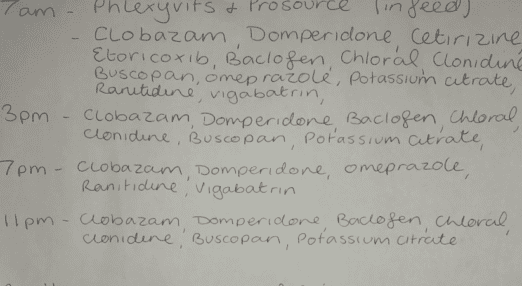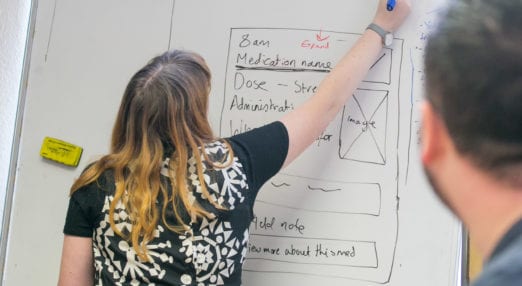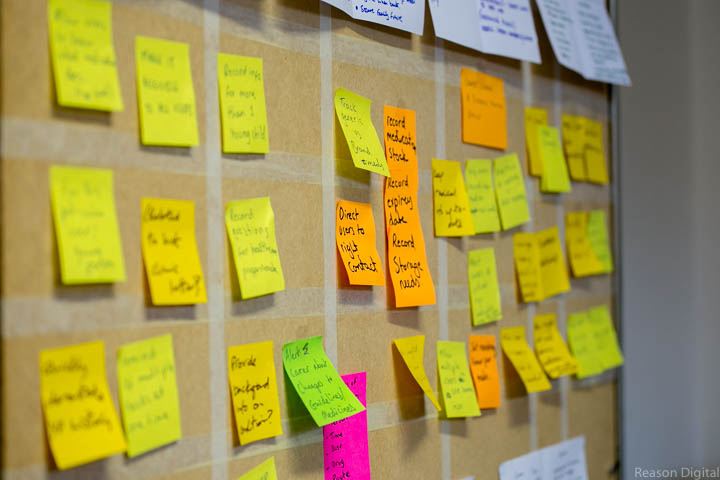An app to relieve the pressure
Through WellChild, we learnt that a seriously ill child with complex health needs requires parents to manage an intricate medicine routine around the clock. This is a relentless and pressured responsibility involving cumbersome routines and very little support.
Balancing this against work and potentially caring for other children can make life feel impossible.
Through a product design sprint, we designed and built an app for parents, meaning that support would literally be in their hands whenever and wherever they needed it. The app would allow parents to record medicine needs safely, producing a clear log of all medicines, doses and schedules for their child (or children).
Automatic reminders for when doses are due would take the pressure off, and medical plans could be shared with medical professionals and other carers to allow a more joined-up approach to supporting parents look after their children.
A parent’s reality
Due to their demanding care routines, not as many parents as we would have liked were able to join us in-person at the design sprint. So we asked them to complete WhatsApp diaries to give us a snapshot of what a week in their shoes was like. Through their diaries, parents shared messages, photographs, and videos that detailed their day-to-day lives caring for their children with complex needs. We were able to use these diaries to piece together insights from a variety of different situations. What we found out was absolutely incredible.
One shared theme that came up time and time again was the use of makeshift charts to manage complex medicine routines: we saw cupboard charts, bedroom charts, fridge charts, MARS charts, wall charts and more. These were also supported by non-medical mobile tools, with alarms and reminders set on phones, as well as (digital) notes on, and photos of the medicines. One parent sent us a screenshot of the alarms set on their phone – no less than 7 times a day!
These charts and tools were accompanied often by heart-wrenching photography of poorly children in hospital and messages of near-despair from sleep-deprived parents.
The impact

App prototype created for parents to manage medicine routines and better coordinate with healthcare professionals

Funding achieved WellChild were successful in gaining funding from Comic Relief's 2018 Tech for Good fund
The challenge
WellChild, the national charity for sick children and their partner organisations, RCPCH and NPPG who together make up Medicines for Children, recognised the strain parents of children with complex health needs were under. They wanted a solution to make the management of medicine routines simpler and less draining for parents, helping them reclaim some of their own headspace.
However, it was crucial that any new product or service that we developed genuinely met parents’ needs. There’s a lot at stake with any medicine management solution so we couldn’t afford to make assumptions, and we certainly couldn’t wait until the end of a project to discover whether (or not!) what we built would actually change lives for the better.
"As a parent/carer you want to be confident you’re doing it correctly with accurate information and not putting your child at risk."
The process
For one intensive week, key members of staff at WellChild and Reason Digital, alongside real service users – parents/carers of children with complex medical needs – worked together to understand the challenges around medicine management, and rapidly co-design and test a prototype based on this insight.
We did this through something called a digital product design sprint. This allowed us to go through the process of understanding, ideating, designing and testing – a process which would traditionally take months – in just one week!
Made popular by Google Ventures (the venture capital investment arm of Google), we’ve tailored the design sprint process to work specifically for pro-social organisations. Here’s how the week typically breaks down:
- On Day 1 of the sprint (“Understand”), we undertake exercises to thoroughly understand the problem we’re trying to solve, such as persona mapping and interviews with beneficiaries and stakeholders. We also perform competitor analysis and create a preliminary assumption map, to set us up for success throughout the rest of the week and beyond.
- On Day 2 (“Diverge”), the sprint team uses a variety of ideation exercises to create as many design solutions as possible, in a way that is inclusive of everyone in the room. The team openly expand upon and critique each idea. This is where we start to get a sense of common patterns and themes, and direction for our digital solution.
- Day 3 (“Decide”) is all about choosing which ideas to take forward. Assumptions and conflicts are noted, and the ‘product’ is sketched out at a high level, including key features/functionality and how each screen or interface works and interacts with one another.
- On Day 4 (“Prototype”), we hand the baton over to our Designers to create a rapid, testable working prototype.
- Day 5 (“Validate”) sees us test the prototype on real users. By doing this, we are able to gain valuable user interaction insights to inform whether the solution is usable, and any improvements we should make. We also create a sprint report, apply our learnings to the assumption map, and when relevant, help our clients create a funding application.
The danger of assumptions
At Reason, we find that some of the best digital solutions are based on ‘makeshift’ offline fixes that people have created for themselves in lieu of something better being available. What better way to validate demand than in situations where the need has been so great that people have literally taken creating a solution into their own hands? And this was certainly the case for the parents that’d engaged with us through their diaries. In fact, our exhausted, but exceptionally resourceful parents had proven themselves to be expert life hackers.
Typically, one parent does most of the complex care around the clock, so we found that everything works well until that parent gets sick, or has to go away, or the family wants to take a break away from their usual routine. When these often unavoidable changes occur, there was a significant risk that this perfectly ordered system would fail.
In addition to this, most parents told us that their greatest challenge was communicating with other carers and healthcare professionals about their child’s medication. They were concerned about having to act as the coordinator in sharing up-to-date information between different healthcare professionals and were often stressed about coordinating multiple carers looking after their child’s/children’s medical needs.

When WellChild and Medicine for Children approached us with their idea, our assumption was that we would create a digital tool to support parents to manage their children’s medicine routines. However, through our process of understanding the problem, utilising insight from people who were experiencing it every day, it was clear that any digital solution we created also needed to be shareable, in order to widen the network of support for parents by facilitating communication between them, NHS professionals and other family carers.
The solution that we agreed on was an app for parents, so that support would literally be in their hands whenever and wherever they needed it. The app would allow parents to record medicine needs safely, producing a clear log of all medicines, doses, and schedules for their child (or children). Automatic reminders for when doses are due would take the pressure off, and medical plans could be shared with medical professionals and other carers to allow a more joined-up approach to supporting parents look after their children.
When it came to testing our app prototype with parents on the final day, we were able to gain some key insights. For example, we found that the mechanism of marking an action as ‘complete’ was too simple, risking a parent or carer saying they had administered the medicine when it hadn’t been. Based on this insight, we were able to make subtle changes to the prototype which made a massive impact on usability.
Only the beginning
WellChild have recently secured additional funding which will enable the development of crucial features and functionality which will enhance its value to parents and carers.
Our longer-term ambition for the project is that at the point of their child being prescribed a medicine, every parent across the UK will be directed to the Medicines for Children app. We also plan to expand the impact that we’re making by utilising the technology to support other groups. We believe that our co-creation process has stood us in good stead to achieve this goal, and are excited to continue to work in partnership with WellChild, alongside parents, families, practitioners and other individuals and organisations sector-wide to make it a reality.
The Medicines for Children app has been a really special project to work on. The potential to make a real difference to the lives of children with complex medical needs and crucially their parents and carers is truly massive.
We had no idea of the mammoth amount of organisation and time required to administer care for just a single child, until we spent time listening to and working with the amazing parents, nurses, doctors and carers. As a result this project is something we haven’t undertaken lightly - always making sure that user safety was front and foremost in our approach. We knew that digital, employed in the right way would be able to help and we’ve spent a long time researching and discovering exactly what the issues are (of which there are many) before started our design and build phases.
As a result, we've received some great feedback from user testing. We can’t wait to start on the next phase of work!
Let's explore design sprints
Product design sprints are an intense, innovative and impactful way to go from problem to prototype
Keep learning